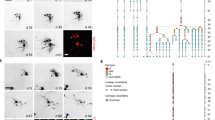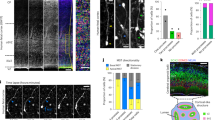Abstract
A comprehensive understanding of the cell biology of adult neural stem cells (aNSCs) requires direct observation of aNSC division and lineage progression in the absence of niche-dependent signals. Here we describe a culture preparation of the adult mouse subependymal zone (SEZ), which allows for continuous single-cell tracking of aNSC behavior. The protocol involves the isolation (∼3 h) and culture of cells from the adult SEZ at low density in the absence of mitogenic growth factors in chemically defined medium and subsequent live imaging using time-lapse video microscopy (5–7 d); these steps are followed by postimaging immunocytochemistry to identify progeny (∼7 h). This protocol enables the observation of the progression from slow-dividing aNSCs of radial/astroglial identity up to the neuroblast stage, involving asymmetric and symmetric cell divisions of distinct fast-dividing precursors. This culture provides an experimental system for studying instructive or permissive effects of signal molecules on aNSC modes of cell division and lineage progression.
This is a preview of subscription content, access via your institution
Access options
Subscribe to this journal
Receive 12 print issues and online access
$259.00 per year
only $21.58 per issue
Buy this article
- Purchase on Springer Link
- Instant access to full article PDF
Prices may be subject to local taxes which are calculated during checkout





Similar content being viewed by others
References
Kriegstein, A. & Alvarez-Buylla, A. The glial nature of embryonic and adult neural stem cells. Annu. Rev. Neurosci. 32, 149–184 (2009).
Beckervordersandforth, R. et al. In vivo fate mapping and expression analysis reveals molecular hallmarks of prospectively isolated adult neural stem cells. Cell Stem Cell 7, 744–758 (2010).
Doetsch, F., Caille, I., Lim, D.A., Garcia-Verdugo, J.M. & Alvarez-Buylla, A. Subventricular zone astrocytes are neural stem cells in the adult mammalian brain. Cell 97, 703–716 (1999).
Doetsch, F., Garcia-Verdugo, J.M. & Alvarez-Buylla, A. Regeneration of a germinal layer in the adult mammalian brain. Proc. Natl. Acad. Sci. USA 96, 11619–11624 (1999).
Pastrana, E., Cheng, L.C. & Doetsch, F. Simultaneous prospective purification of adult subventricular zone neural stem cells and their progeny. Proc. Natl. Acad. Sci. USA 106, 6387–6392 (2009).
Mirzadeh, Z., Merkle, F.T., Soriano-Navarro, M., Garcia-Verdugo, J.M. & Alvarez-Buylla, A. Neural stem cells confer unique pinwheel architecture to the ventricular surface in neurogenic regions of the adult brain. Cell Stem Cell 3, 265–278 (2008).
Doetsch, F., Petreanu, L., Caille, I., Garcia-Verdugo, J.M. & Alvarez-Buylla, A. EGF converts transit-amplifying neurogenic precursors in the adult brain into multipotent stem cells. Neuron 36, 1021–1034 (2002).
Reynolds, B.A. & Weiss, S. Generation of neurons and astrocytes from isolated cells of the adult mammalian central nervous system. Science 255, 1707–1710 (1992).
Reynolds, B.A. & Rietze, R.L. Neural stem cells and neurospheres—re-evaluating the relationship. Nat. Methods 2, 333–336 (2005).
Rietze, R.L. & Reynolds, B.A. Neural stem cell isolation and characterization. Methods Enzymol. 419, 3–23 (2006).
Kuhn, H.G., Winkler, J., Kempermann, G., Thal, L.J. & Gage, F.H. Epidermal growth factor and fibroblast growth factor-2 have different effects on neural progenitors in the adult rat brain. J. Neurosci. 17, 5820–5829 (1997).
Pastrana, E., Silva-Vargas, V. & Doetsch, F. Eyes wide open: a critical review of sphere-formation as an assay for stem cells. Cell Stem Cell 8, 486–498 (2011).
Costa, M.R. et al. Continuous live imaging of adult neural stem cell division and lineage progression in vitro. Development 138, 1057–1068 (2011).
Schroeder, T. Long-term single-cell imaging of mammalian stem cells. Nat. Methods 8, S30–S35 (2011).
Price, J., Turner, D. & Cepko, C. Lineage analysis in the vertebrate nervous system by retrovirus-mediated gene transfer. Proc. Natl. Acad. Sci. USA 84, 156–160 (1987).
Williams, B.P., Read, J. & Price, J. The generation of neurons and oligodendrocytes from a common precursor cell. Neuron 7, 685–693 (1991).
Lim, D.A. & Alvarez-Buylla, A. Interaction between astrocytes and adult subventricular zone precursors stimulates neurogenesis. Proc. Natl. Acad. Sci. USA 96, 7526–7531 (1999).
Laywell, E.D., Rakic, P., Kukekov, V.G., Holland, E.C. & Steindler, D.A. Identification of a multipotent astrocytic stem cell in the immature and adult mouse brain. Proc. Natl. Acad. Sci. USA 97, 13883–13888 (2000).
Brill, M.S. et al. Adult generation of glutamatergic olfactory bulb interneurons. Nat. Neurosci. 12, 1524–1533 (2009).
Brill, M.S. et al. A dlx2- and pax6-dependent transcriptional code for periglomerular neuron specification in the adult olfactory bulb. J. Neurosci. 28, 6439–6452 (2008).
Qian, X., Goderie, S.K., Shen, Q., Stern, J.H. & Temple, S. Intrinsic programs of patterned cell lineages in isolated vertebrate CNS ventricular zone cells. Development 125, 3143–3152 (1998).
Shen, Q. et al. The timing of cortical neurogenesis is encoded within lineages of individual progenitor cells. Nat. Neurosci. 9, 743–751 (2006).
Ravin, R. et al. Potency and fate specification in CNS stem cell populations in vitro. Cell Stem Cell 3, 670–680 (2008).
Rieger, M.A., Hoppe, P.S., Smejkal, B.M., Eitelhuber, A.C. & Schroeder, T. Hematopoietic cytokines can instruct lineage choice. Science 325, 217–218 (2009).
Nolte, C. et al. GFAP promoter-controlled EGFP-expressing transgenic mice: a tool to visualize astrocytes and astrogliosis in living brain tissue. Glia 33, 72–86 (2001).
Westerlund, U. et al. Endoscopically harvested stem cells: a putative method in future autotransplantation. Neurosurgery 57, 779–784; discussion 779–784 (2005).
Moe, M.C. et al. Multipotent progenitor cells from the adult human brain: neurophysiological differentiation to mature neurons. Brain 128, 2189–2199 (2005).
Sanai, N. et al. Unique astrocyte ribbon in adult human brain contains neural stem cells but lacks chain migration. Nature 427, 740–744 (2004).
Merkle, F.T., Mirzadeh, Z. & Alvarez-Buylla, A. Mosaic organization of neural stem cells in the adult brain. Science 317, 381–384 (2007).
Hack, M.A. et al. Neuronal fate determinants of adult olfactory bulb neurogenesis. Nat. Neurosci. 8, 865–872 (2005).
Morshead, C.M. et al. Neural stem cells in the adult mammalian forebrain: a relatively quiescent subpopulation of subependymal cells. Neuron 13, 1071–1082 (1994).
Zheng, W., Nowakowski, R.S. & Vaccarino, F.M. Fibroblast growth factor 2 is required for maintaining the neural stem cell pool in the mouse brain subventricular zone. Dev. Neurosci. 26, 181–196 (2004).
Cohen, A.R., Gomes, F.L., Roysam, B. & Cayouette, M. Computational prediction of neural progenitor cell fates. Nat. Methods 7, 213–218 (2010).
Tang, F., Lao, K. & Surani, M.A. Development and applications of single-cell transcriptome analysis. Nat. Methods 8, S6–S11 (2011).
Hirrlinger, P.G. et al. Expression of reef coral fluorescent proteins in the central nervous system of transgenic mice. Mol. Cell Neurosci. 30, 291–303 (2005).
Couillard-Despres, S. et al. Doublecortin expression levels in adult brain reflect neurogenesis. Eur. J. Neurosci. 21, 1–14 (2005).
Couillard-Despres, S. et al. Targeted transgene expression in neuronal precursors: watching young neurons in the old brain. Eur. J. Neurosci. 24, 1535–1545 (2006).
Eilken, H. et al. Continuous long-term detection of live cell surface markers by 'in culture' antibody staining. Protocol Exchange (2011)doi:10.1038/protex.2011.205.
Bibel, M., Richter, J., Lacroix, E. & Barde, Y.A. Generation of a defined and uniform population of CNS progenitors and neurons from mouse embryonic stem cells. Nat. Protoc. 2, 1034–1043 (2007).
Chen, Y. et al. NS21: re-defined and modified supplement B27 for neuronal cultures. J. Neurosci. Methods 171, 239–247 (2008).
Ory, D.S., Neugeboren, B.A. & Mulligan, R.C. A stable human-derived packaging cell line for production of high titer retrovirus/vesicular stomatitis virus G pseudotypes. Proc. Natl. Acad. Sci. USA 93, 11400–11406 (1996).
Heinrich, C. et al. Generation of subtype-specific neurons from postnatal astroglia of the mouse cerebral cortex. Nat. Protoc. 6, 214–228 (2011).
Tashiro, A., Zhao, C. & Gage, F.H. Retrovirus-mediated single-cell gene knockout technique in adult newborn neurons in vivo. Nat. Protoc. 1, 3049–3055 (2006).
Billon, N., Jolicoeur, C. & Raff, M. Generation and characterization of oligodendrocytes from lineage-selectable embryonic stem cells in vitro. Methods Mol. Biol. 330, 15–32 (2006).
Costa, M.R., Bucholz, O., Schroeder, T. & Gotz, M. Late origin of glia-restricted progenitors in the developing mouse cerebral cortex. Cereb. Cortex 19 (Suppl 1): i135–i143 (2009).
Costa, M.R., Wen, G., Lepier, A., Schroeder, T. & Gotz, M. Par-complex proteins promote proliferative progenitor divisions in the developing mouse cerebral cortex. Development 135, 11–22 (2008).
Acknowledgements
This work was supported by grants from the Deutsche Forschungsgemeinschaft to B.B. and M.G. (BE 4182/2-2 and GO 640/9-2) and to T.S. (SCHR 1142/1-2), and from the Bundesministerium für Bildung und Forschung (NewNeurons) and the Bavarian State Ministry of Sciences, Research and the Arts (ForNeuroCell) to B.B. and M.G.
Author information
Authors and Affiliations
Contributions
F.O. and M.R.C. contributed to protocol design, experimental analysis of the culture preparation by single-cell tracking, postimaging ICC and clonal analysis, and the preparation of the manuscript; T.S.-E. contributed to the culture preparation; T.S. contributed to single-cell tracking by time-lapse video microscopy; M.G. contributed to protocol design and preparation of the manuscript; B.B. developed the culture preparation and contributed to protocol design, experimental analysis and preparation of the manuscript.
Corresponding author
Ethics declarations
Competing interests
The authors declare no competing financial interests.
Supplementary information
Supplementary Fig. 1
Summary of lineage trees derived from a single live imaging experiment. Each lineage tree was reconstructed from phase contrast image sequences using TTT. Shown are all lineage trees derived from cells which underwent cell division. After imaging, the identity of each cell was determined by post-imaging immunocytochemistry for βIII tubulin (neuronal) and GFAP (astroglial). N, neuron; G, astroglia; ?, marker negative; X, cell death. (PDF 449 kb)
Supplementary Video 1
Tracking options in TTT software. The video shows the three different outcomes labelled (1) cell division, (2) apoptosis (including any kind of cell death) and (3) cell lost (due to formation of cell aggregates as shown in the video or exit from field of view by the tracked cells), as assigned by the investigator during single cell tracking with the support by the TTT software. (AVI 43101 kb)
Supplementary Video 2
Adult neural stem cell lineage tree. The video shows the lineage progression of the aNSC (black arrow) depicted in Fig. 5a,c. The left panel shows the sequence of phase contrast images and the right panel the corresponding development of the lineage trees. Note the generation of both neuronal and astroglial progeny, as indicated by the final image following post-imaging immunocytochemistry. (AVI 89373 kb)
Rights and permissions
About this article
Cite this article
Ortega, F., Costa, M., Simon-Ebert, T. et al. Using an adherent cell culture of the mouse subependymal zone to study the behavior of adult neural stem cells on a single-cell level. Nat Protoc 6, 1847–1859 (2011). https://doi.org/10.1038/nprot.2011.404
Published:
Issue Date:
DOI: https://doi.org/10.1038/nprot.2011.404
This article is cited by
-
Post-transcriptional control of a stemness signature by RNA-binding protein MEX3A regulates murine adult neurogenesis
Nature Communications (2023)
-
The extracellular matrix molecule tenascin-C modulates cell cycle progression and motility of adult neural stem/progenitor cells from the subependymal zone
Cellular and Molecular Life Sciences (2022)
-
Neurovascular EGFL7 regulates adult neurogenesis in the subventricular zone and thereby affects olfactory perception
Nature Communications (2017)
-
The Hippo signalling pathway maintains quiescence in Drosophila neural stem cells
Nature Communications (2016)
-
Anosmin-1 over-expression increases adult neurogenesis in the subventricular zone and neuroblast migration to the olfactory bulb
Brain Structure and Function (2016)
Comments
By submitting a comment you agree to abide by our Terms and Community Guidelines. If you find something abusive or that does not comply with our terms or guidelines please flag it as inappropriate.



